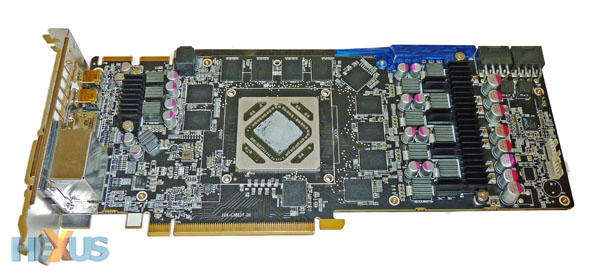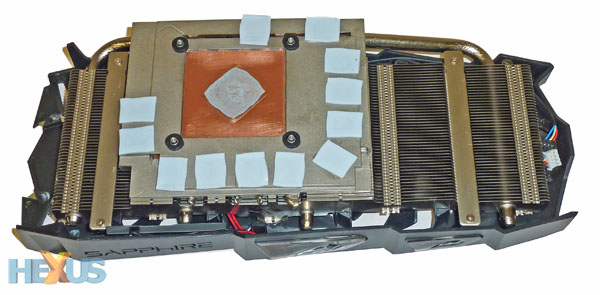Closer look
Premium Radeon cards ship with a small switch, near the two CrossFireX connectors, that usually load one of two BIOS profiles. Sometimes flicking over from position one to two has no effect; the manufacturer doesn't bother with a second, performance-enhancing BIOS. Sapphire, though, has a special gizmo, dubbed the 'Lethal Boost Button,' in place of the tiny switch. Leave the button in the 'off' state and the card marginally betters the GHz Edition GPU by clocking in at 1,100MHz core; memory speed remains at 6,000MHz. Sapphire appears to override the AMD auto-boost feature, thus maintaining 1,100MHz, and no more, during gaming sessions.
Would-be purchasers are likely to skirt straight past the as-shipping TOXIC clocks and go for a dose of lethality, as pressing said button programs the card with a core speed of 1,100MHz and memory at an effective 6,400MHz, together with a more-aggressive fan-speed profile, representing the fastest Radeon speeds we've ever seen. What's more, the PowerTune with Boost feature is then activated, to jump by 100MHz, thus delivering a potential core frequency of 1,200MHz. Yes sir, a 1,200/6,400MHz-clocked HD 7970 is a thing of geeky beauty. Best of all, the Lethal Boost button lights up blue!
Bear in mind that jumping from one BIOS to another also increases under-load GPU voltage from 1.256V to 1.281V. The increase may not sound like much, but when coupled with faster clocks, power-draw and fan noise increase significantly; you'll see what we mean a little later on in the review.
Sapphire is moved to change AMD's default video outputs, too. The TOXIC pulls in dual-link DVI; single-link DVI, HDMI and two mini-DisplayPort. Anyone considering such a graphics behemoth is likely to at least contemplate running three screens in tandem, so it's a slight shame that Sapphire doesn't 'Flex' the DVI outputs, whereby three screens can be connected to the pair of DVI and the HDMI outputs. Help is at hand in the package, though, as an active mini-DisplayPort-to-DVI adapter is bundled. Long story short, you can use at least three screens, for gaming, without having to purchase additional hardware.
A full-width cooling plate is contained on the backside. Zoom into the top-right corner and there are six LEDs - three green, two amber, and a red - that give a rough-and-ready guide to PCB temperature. The main reason for the presence of a backplate is to help with heat dissipation and protection of 12 rear-mounted memory modules, which is unusual, as card memory is almost always contained on the GPU side. The reason for this, as it happens, is rather simple: the TOXIC has 6GB of GDDR5 memory, split over 12 chips on both sides.
Regular Radeon HD 7970s ship with a 3GB framebuffer, albeit all contained on one side. Sapphire, then, uses two lots of regular-density GDDR5 modules to achieve a 6GB (6,144MB) buffer. We've seen very few, if any, occasions where the 3GB is swamped enough to cause in-game slowdowns, so 6GB is a luxury. We guess it works well from a marketing viewpoint more than for pragmatic usage with the games of today, though we'll be testing its efficiency in a three-monitor performance evaluation shortly.
The brown PCB looks like a standard HD 7970's on first glance, but this is patently not the case. TOXIC uses two eight-pin connectors, upgraded power-delivery components, double-sided memory, two fan-headers, and different outputs from AMD's design, for starters.
The cooler has the Ian Bothams about it; it's veritably beefy. A second power connector drives the LEDs behind the Sapphire logo. Standing over two slots tall and unlike the one found on the Dual-X OC version, this cooling monster really is about as good as it gets for air-based heatsinks.
Now we come, finally, to the ever-thorny issue of price. The cheapest Radeon HD 7970s now ship from £320, while partner-overclocked variants start from £340, and those based on the GHz chip sit above £350. This TOXIC is likely to retail for at least £500, we believe, when it becomes available in limited quantities. It's not cheap, granted, but it was never going to be, frankly.













